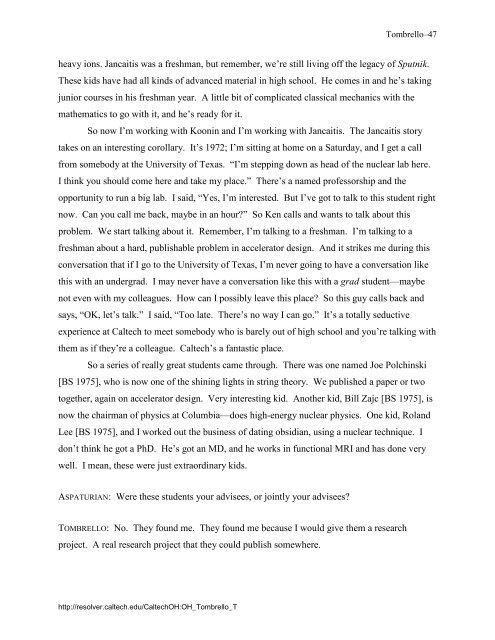Interview with Thomas A. Tombrello - Caltech Oral Histories
Interview with Thomas A. Tombrello - Caltech Oral Histories
Interview with Thomas A. Tombrello - Caltech Oral Histories
Create successful ePaper yourself
Turn your PDF publications into a flip-book with our unique Google optimized e-Paper software.
<strong>Tombrello</strong>–47<br />
heavy ions. Jancaitis was a freshman, but remember, we’re still living off the legacy of Sputnik.<br />
These kids have had all kinds of advanced material in high school. He comes in and he’s taking<br />
junior courses in his freshman year. A little bit of complicated classical mechanics <strong>with</strong> the<br />
mathematics to go <strong>with</strong> it, and he’s ready for it.<br />
So now I’m working <strong>with</strong> Koonin and I’m working <strong>with</strong> Jancaitis. The Jancaitis story<br />
takes on an interesting corollary. It’s 1972; I’m sitting at home on a Saturday, and I get a call<br />
from somebody at the University of Texas. “I’m stepping down as head of the nuclear lab here.<br />
I think you should come here and take my place.” There’s a named professorship and the<br />
opportunity to run a big lab. I said, “Yes, I’m interested. But I’ve got to talk to this student right<br />
now. Can you call me back, maybe in an hour?” So Ken calls and wants to talk about this<br />
problem. We start talking about it. Remember, I’m talking to a freshman. I’m talking to a<br />
freshman about a hard, publishable problem in accelerator design. And it strikes me during this<br />
conversation that if I go to the University of Texas, I’m never going to have a conversation like<br />
this <strong>with</strong> an undergrad. I may never have a conversation like this <strong>with</strong> a grad student—maybe<br />
not even <strong>with</strong> my colleagues. How can I possibly leave this place? So this guy calls back and<br />
says, “OK, let’s talk.” I said, “Too late. There’s no way I can go.” It’s a totally seductive<br />
experience at <strong>Caltech</strong> to meet somebody who is barely out of high school and you’re talking <strong>with</strong><br />
them as if they’re a colleague. <strong>Caltech</strong>’s a fantastic place.<br />
So a series of really great students came through. There was one named Joe Polchinski<br />
[BS 1975], who is now one of the shining lights in string theory. We published a paper or two<br />
together, again on accelerator design. Very interesting kid. Another kid, Bill Zajc [BS 1975], is<br />
now the chairman of physics at Columbia—does high-energy nuclear physics. One kid, Roland<br />
Lee [BS 1975], and I worked out the business of dating obsidian, using a nuclear technique. I<br />
don’t think he got a PhD. He’s got an MD, and he works in functional MRI and has done very<br />
well. I mean, these were just extraordinary kids.<br />
ASPATURIAN: Were these students your advisees, or jointly your advisees?<br />
TOMBRELLO: No. They found me. They found me because I would give them a research<br />
project. A real research project that they could publish somewhere.<br />
http://resolver.caltech.edu/<strong>Caltech</strong>OH:OH_<strong>Tombrello</strong>_T

















